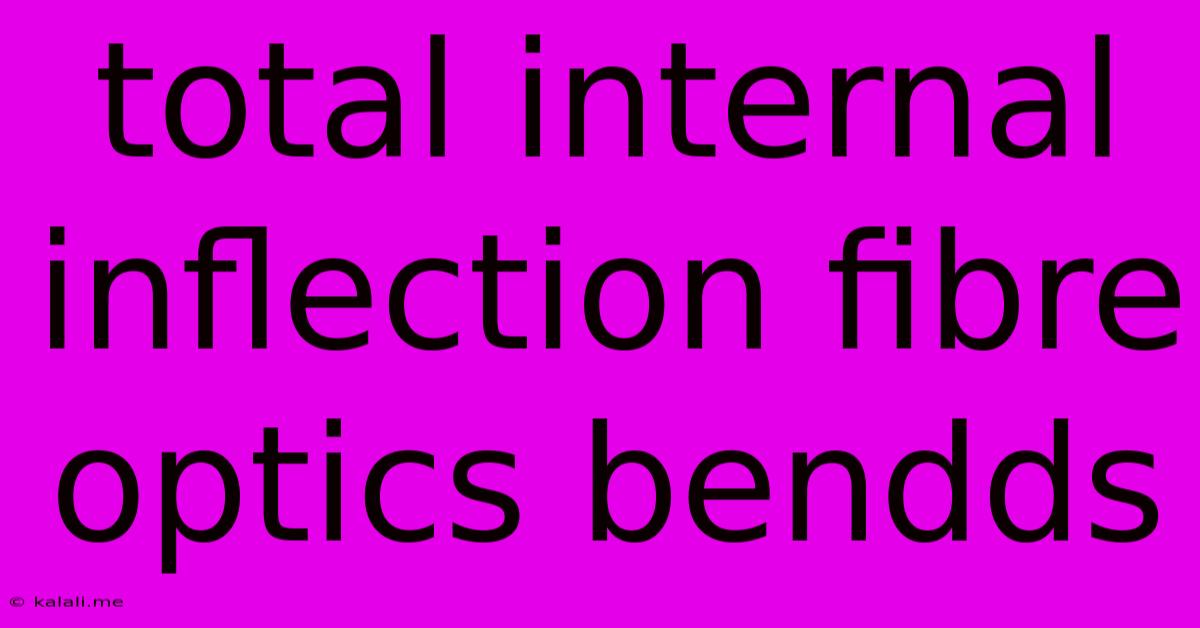Total Internal Inflection Fibre Optics Bendds
Kalali
Jun 04, 2025 · 3 min read

Table of Contents
Total Internal Reflection and Fiber Optic Bends: Understanding the Critical Angle
Fiber optic cables rely on the principle of total internal reflection (TIR) to transmit light signals over long distances with minimal signal loss. This phenomenon occurs when light traveling within a denser medium (like the core of an optical fiber) strikes the boundary with a less dense medium (like the cladding) at an angle greater than a critical angle. Understanding this relationship, particularly concerning bends in the fiber, is crucial for optimizing fiber optic communication systems. This article delves into the physics behind TIR, the impact of bends, and the importance of maintaining the critical angle to ensure efficient signal transmission.
What is Total Internal Reflection?
Total internal reflection is a fundamental concept in optics. When light passes from a denser medium (higher refractive index) to a less dense medium (lower refractive index), it refracts (bends) away from the normal (a line perpendicular to the surface). However, as the angle of incidence increases, the angle of refraction also increases until, at a certain angle, the refracted ray travels along the boundary between the two media. This angle is called the critical angle. Beyond the critical angle, the light is entirely reflected back into the denser medium – this is total internal reflection.
The critical angle (θc) can be calculated using Snell's Law:
sin θc = n₂/n₁
Where:
- n₁ is the refractive index of the denser medium (fiber core)
- n₂ is the refractive index of the less dense medium (fiber cladding)
Fiber Optic Bends and TIR:
The efficiency of total internal reflection in fiber optics is directly affected by bends in the cable. A sharp bend can reduce the angle of incidence of the light ray below the critical angle. This leads to:
- Signal Loss: Instead of being reflected internally, light escapes the core into the cladding, resulting in attenuation (signal weakening).
- Modal Dispersion: Different light rays within the fiber will travel different paths, causing them to arrive at the receiver at different times, blurring the signal. This is especially pronounced in multi-mode fibers.
- Macrobending Loss: This refers to large-scale bends, which often cause significant signal loss.
Minimizing Signal Loss in Bends:
To minimize signal loss due to bending, several strategies are employed:
- Careful Cable Handling: Proper handling and installation techniques are crucial to avoid sharp bends. Using cable trays, proper strain relief, and avoiding excessive twisting help prevent excessive bending.
- Fiber Optic Cable Design: Manufacturers design fibers with a specific core-cladding refractive index difference, and use materials with high refractive indices to maximize the critical angle, making them more tolerant to bending.
- Microbending Loss: This relates to tiny imperfections in the cable that cause micro-bends. These need careful attention during manufacturing and installation to minimize their impact.
- Bend-Insensitive Fibers: Advanced fiber optic designs, such as photonic crystal fibers, are inherently less sensitive to bending losses due to their unique structural properties.
Conclusion:
Total internal reflection is paramount to the successful operation of fiber optic communication systems. Understanding the critical angle and the impact of bends, both macro and micro, is vital for designing, installing, and maintaining efficient optical networks. By adhering to best practices in cable handling and selecting appropriate fiber types, significant signal loss can be avoided, ensuring reliable high-speed data transmission. Continued research and development in fiber optic technology continue to improve the bend-resistance and overall performance of these essential communication systems.
Latest Posts
Latest Posts
-
Can Shimano Derailleur Work On Campagnolo Cassette
Jun 06, 2025
-
How Often To Seal Granite Countertops
Jun 06, 2025
-
What Form Of Light Causes Molecular Vibratino
Jun 06, 2025
-
How To Say Screw You In French
Jun 06, 2025
-
What Does Ich Liebe Dich Mean
Jun 06, 2025
Related Post
Thank you for visiting our website which covers about Total Internal Inflection Fibre Optics Bendds . We hope the information provided has been useful to you. Feel free to contact us if you have any questions or need further assistance. See you next time and don't miss to bookmark.